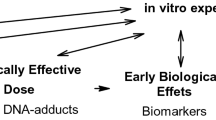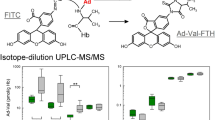Abstract
Covalent binding to hemoglobin was studied to further substantiate the proposal that it may be used for biomonitoring N-substituted aryl compounds. (14C)-Labeled acetanilide and nitrobenzene were orally administered to female Wistar rats and binding indices [Binding(mmol/mol Hb)/Dose(mmol/kg)] determined; these were 12±1 and 73±10, respectively. After mild acidic or alkaline hydrolysis, 90% of the bound material was released and identified as aniline by radio thin layer chromatography. This supports the hypothesis that nitroso aryl derivatives, common intermediates in the metabolism of N-substituted aryl compounds, react with SH-groups of hemoglobin to yield sulfinic acid amides. Aniline was furthermore identified and quantified by capillary gas chromatography, using hemoglobin from animals treated with unlabeled aniline and nitrobenzene. Binding indices in this case were 30±3 and 85±19, respectively. With this method human blood samples may also be analysed.
Although nitrobenzene is known to produce less methemoglobin than aniline, hemoglobin binding is higher. This indicates that hemoglobin binding may be a better index of body burden than methemoglobin levels in biomonitoring N-substituted aryl compounds.
Similar content being viewed by others
References
Beauchamp RO jr, Irons RD, Rickert DE, Couch DB, Hamm TE jr (1982) A critical review of the literature on nitrobenzene toxicity. CRC Crit Rev Toxicol 11: 33–55
Chemical Industry Institute of Toxicology (CIIT) (1982) Final report. 104-weak chronic toxicity study in rats, aniline chloride. Research Triangle Park, N.C. USA
Chua CG, Carrell RW, Howard BH (1975) The amino acid sequence of the α-chain of the major hemoglobin of the rat (rattus norvegicus) Biochem J 149: 259–269
Deutsche Forschungsgemeinschaft (1983) MAK-Werte, Toxikologisch-Arbeitsmedizinische Begründungen. Anilin, Verlag Chemie, Weinheim
Dölle B, Töpner W, Neumann H-G (1980) Reaction of arylnitroso compounds with mercaptans. Xenobiotica 10: 527–536
Dutkiewicz T (1961) Med. Pracy 12, 1, zitiert in Deutsche Forschungsgemeinschaft (1983)
Eyer P (1979) Reactions of nitrosobenzene with reduced glutathione. Chem-Biol Interact 24: 227–239
Eyer P, Lierheimer E (1980) Biotransformation of nitrosobenzene in the red cell and the role of glutathione. Xenobiotica 10: 517–526
Garrick LM, Sharma VS, McDonald MJ, Ronney HM (1975) Rat hemoglobin heterogeneity. Biochem J 149: 245–258
Garrick LM, Sloan RL, Ryan TW, Klonowski TJ, Garrick MD (1978) Primary structure of the major β-chain of rat hemoglobin. Biochem J 173: 321–330
Goldstein RS, Rickert DE (1984) Macromolecular covalent binding of (14 C)-nitrobenzene in the erythrocyte and spleen of rats and mice. Chem-Biol Interact 50: 27–37
Grob K, Grob K jr (1974) Isothermal analysis on capillary columns without stream splitting. J Chromatr 94: 53–64
Kiese M (1974) Methemoglobinemia: A comprehensive treatise. CRC Press, Inc., Cleveland, Oh, USA
Kiese M, Taeger K (1976) The fate of phenylhydroxylamine in human red cells. Naunyn-Schmiedebergs Arch Exp Path Pharmacol 293: 59–66
Levin AA, Dent JG (1982) Comparison of the metabolism of nitrobenzene by hepatic microsomes and cecal microflora from Fischer-344 rats in vitro and the relative importance of each in vivo. Drug Metab Dispos 10: 450–454
National Cancer Institute (NCI) (1978) Bioassay of aniline hydrochloride for possible carcinogenicity, NCI-Bioassay Report No 130, US DHEW, Bethesda, Md, USA
Neumann H-G (1984a) Analysis of hemoglobin as a dose monitor for alkylating and arylating agents. Arch Toxicol 56: 1–6
Neumann H-G (1984b) Dosimetry and dose-response relationships. International Agency of Research on Cancer Publications (in press)
Reddy BG, Pohl TR, Krishna G (1976) The requirement of gut flora in nitrobenzene-induced methamoglobinemia in rats. Biochem Pharmacol 25: 1119–1122
Rickert DE, Bond IA, Long RM, Chism IP (1983) Metabolism and excretion of nitrobenzene by rats and mice. Toxicol Appl Pharmacol 67: 206–214
Uehleke H (1964) Nitrosobenzol im Blute von Katzen nach Verabreichung von Nitrobenzol. Naunyn-Schmiedebergs Arch Exp Path Pharmacol 247: 412–418
Author information
Authors and Affiliations
Rights and permissions
About this article
Cite this article
Albrecht, W., Neumann, H.G. Biomonitoring of aniline and nitrobenzene. Arch Toxicol 57, 1–5 (1985). https://doi.org/10.1007/BF00286566
Received:
Accepted:
Issue Date:
DOI: https://doi.org/10.1007/BF00286566




